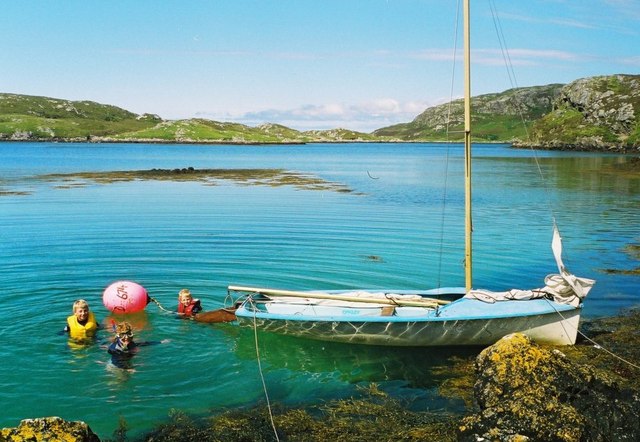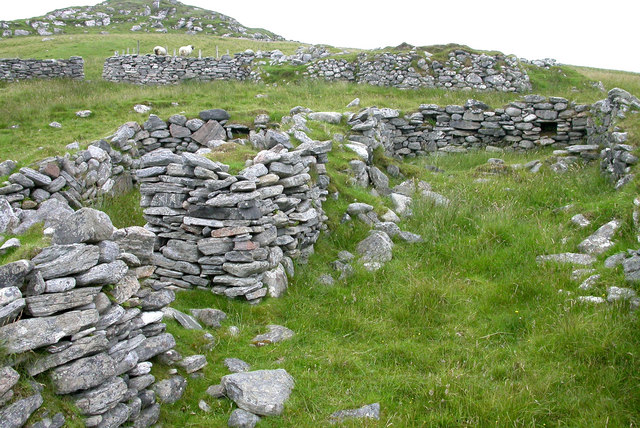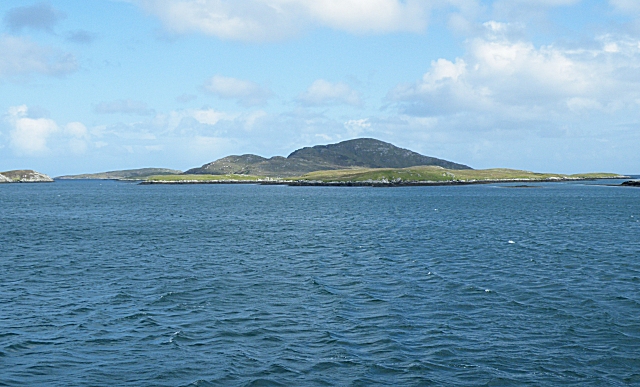|
Hellisay
Hellisay (Scottish Gaelic: ''Theiliseigh'') is a currently uninhabited island and is one of ten islands in the Sound of Barra, a Site of Community Importance for conservation in the southern Outer Hebrides of Scotland. The narrow Sound of Gighay lies between Hellisay and its neighbouring island. Geography and geology Hellisay is one of ten islands in the Sound of Barra, a Site of Community Importance for conservation in the Outer Hebrides of Scotland. of a string of islands in the Sound of Barra, Hellisay lies close to its neighbour Gighay, with a narrow channel, the Sound of Gighay, between. The bedrock is mainly gneiss with quartz veins. There are several peaks on the island including Beinn a' Chàrnain in the west (mountain of the small cairn; ), Meall Meadhonach (middle rounded hill; ) and Meall Mòr (east of Meall Meadhonach and south of the peninsula of Càrais; ). Wildlife Along with a variety of seabirds, raptors including falcons and golden eagles have been see ... [...More Info...] [...Related Items...] OR: [Wikipedia] [Google] [Baidu] |
Barra
Barra (; or ; ) is an island in the Outer Hebrides, Scotland, and the second southernmost inhabited island there, after the adjacent island of Vatersay to which it is connected by the Vatersay Causeway. In 2011, the population was 1,174. English and Gaelic are widely spoken, and at the 2011 Census, there were 761 Gaelic speakers (62% of the population, falling from 76% in the 1991 census). Geology In common with the rest of the Western Isles, Barra is formed from the oldest rocks in Britain, the Lewisian gneiss, which dates from the Archean, Archaean eon. Some of the gneiss in the east of the island is noted as being pyroxene-bearing. Layered textures or Foliation (geology), foliation in this metamorphic rock is typically around 30° to the east or northeast. Palaeoproterozoic age diorite, metadiorites and tonalite, metatonalites forming a part of the East Barra Meta-igneous Complex occur around Castlebay as they do on the neighbouring islands of Vatersay and Flodday, So ... [...More Info...] [...Related Items...] OR: [Wikipedia] [Google] [Baidu] |
List Of Islands Of Scotland
This is a list of islands of Scotland, the mainland of which is part of the island of Great Britain. Also included are various other related tables and lists. The definition of an offshore island used in this list is "land that is surrounded by seawater on a daily basis, but not necessarily at all stages of the tide, excluding human devices such as bridges and causeways". Scotland has around 900 offshore islands, most of which are to be found in four main groups: Shetland Islands, Shetland, Orkney Islands, Orkney, and the Hebrides, sub-divided into the Inner Hebrides and Outer Hebrides. There are also clusters of islands in the Firth of Clyde, Firth of Forth, and Solway Firth, and numerous small islands within the many bodies of fresh water in Scotland including Loch Lomond and Loch Maree. The largest island is Lewis and Harris, which extends to , and there are a further 200 islands which are greater than in area. Of the remainder, several, such as Staffa and the Flannan Isles, ... [...More Info...] [...Related Items...] OR: [Wikipedia] [Google] [Baidu] |
List Of The Islands Of The Sound Of Barra
The Sound of Barra is a large ocean inlet or Sound (geography), sound situated to the north of the island, isle of Barra and to the south of South Uist in the Outer Hebrides in Scotland. Since 2014 it has been designated as a Special Area of Conservation (SAC). The Sound of Barra is composed of 98.91% marine and inlet areas, 1.07% mudflats and other semi-submerged areas and 0.02% sea cliffs and islets. There are ten islands in the sound, with only Eriskay still being inhabited: * Calvay * Eriskay * Fiaraidh * Flodday (Sound of Barra), Flodday * Fuday * Fuiay * Gighay * Hellisay * Lingay, Fiaray, Lingay * Orosay There is a ferry service across the sound from Ardmore, Barra, Ardmore () on Barra to Ceann a' Ghàraidh on the island of Eriskay. In 2000 it was proposed that the Sound of Barra should become a SAC. A 12-week consultation process was undertaken by NatureScot, Scottish Natural Heritage (SNH) on behalf of the Scottish Government in the autumn of 2011 with two public meeti ... [...More Info...] [...Related Items...] OR: [Wikipedia] [Google] [Baidu] |
Sound Of Barra
The Sound of Barra is a large ocean inlet or sound situated to the north of the isle of Barra and to the south of South Uist in the Outer Hebrides in Scotland. Since 2014 it has been designated as a Special Area of Conservation (SAC). The Sound of Barra is composed of 98.91% marine and inlet areas, 1.07% mudflats and other semi-submerged areas and 0.02% sea cliffs and islets. There are ten islands in the sound, with only Eriskay still being inhabited: * Calvay * Eriskay * Fiaraidh * Flodday * Fuday * Fuiay * Gighay * Hellisay * Lingay * Orosay There is a ferry service across the sound from Ardmore () on Barra to Ceann a' Ghàraidh on the island of Eriskay. In 2000 it was proposed that the Sound of Barra should become a SAC. A 12-week consultation process was undertaken by Scottish Natural Heritage (SNH) on behalf of the Scottish Government in the autumn of 2011 with two public meetings held in Castlebay on Barra and on Eriskay as well as inviting submissions by letter an ... [...More Info...] [...Related Items...] OR: [Wikipedia] [Google] [Baidu] |
Gighay
Gighay (Scottish Gaelic Gioghaigh) an uninhabited island off the northeast coast of Barra. It is one of ten islands in the Sound of Barra, a Site of Community Importance for conservation in the Outer Hebrides of Scotland. Geography and geology Gighay lies in the Sound of Barra between Barra and Eriskay, southwest of Fuday. One of a string of islands between South Uist and Barra, Gighay is "locked" into its neighbour Hellisay, with a harbour between. It is mainly gneiss with quartz veins. Gighay has an area of and rises steeply to . Gighay is owned by the Scottish Ministers The Scottish Government (, ) is the executive arm of the devolved government of Scotland. It was formed in 1999 as the Scottish Executive following the 1997 referendum on Scottish devolution, and is headquartered at St Andrew's House in t ... (''i.e.'' the Scottish government). Notes and references Islands of the Sound of Barra Uninhabited islands of the Outer Hebrides {{Wes ... [...More Info...] [...Related Items...] OR: [Wikipedia] [Google] [Baidu] |
Old Norse
Old Norse, also referred to as Old Nordic or Old Scandinavian, was a stage of development of North Germanic languages, North Germanic dialects before their final divergence into separate Nordic languages. Old Norse was spoken by inhabitants of Scandinavia and their Viking expansion, overseas settlements and chronologically coincides with the Viking Age, the Christianization of Scandinavia, and the consolidation of Scandinavian kingdoms from about the 8th to the 15th centuries. The Proto-Norse language developed into Old Norse by the 8th century, and Old Norse began to develop into the modern North Germanic languages in the mid- to late 14th century, ending the language phase known as Old Norse. These dates, however, are not precise, since written Old Norse is found well into the 15th century. Old Norse was divided into three dialects: Old West Norse (Old West Nordic, often referred to as ''Old Norse''), Old East Norse (Old East Nordic), and Old Gutnish. Old West Norse and O ... [...More Info...] [...Related Items...] OR: [Wikipedia] [Google] [Baidu] |
Highland Clearances
The Highland Clearances ( , the "eviction of the Gaels") were the evictions of a significant number of tenants in the Scottish Highlands and Islands, mostly in two phases from 1750 to 1860. The first phase resulted from Scottish Agricultural Revolution, agricultural improvement, driven by the need for landlords to increase their income – many had substantial debts, with actual or potential bankruptcy being a large part of the story of the clearances. This involved the enclosure of the Open-field system, open fields managed on the run rig system and shared grazing. These were usually replaced with large-scale Pastoral farming, pastoral farms on which much higher rents were paid. The displaced tenants were expected to be employed in industries such as fishing, quarrying, or Kelp#Uses, kelp harvesting and processing. Their reduction in status from farmer to Croft (land), crofter was one of the causes of resentment. The second phase involved overcrowded crofting communities from ... [...More Info...] [...Related Items...] OR: [Wikipedia] [Google] [Baidu] |
Joan Blaeu
Joan Blaeu (; 23 September 1596 – 21 December 1673), also called Johannes Blaeu, was a Dutch cartographer and the official cartographer of the Dutch East India Company. Blaeu is most notable for his map published in 1648, which was the first map to incorporate the heliocentric theory into a map of the world and was the first map that incorporated the discoveries of Abel Tasman. Blaeu renamed what is now New Zealand as ''Nieuw Zeeland'' after the Dutch province of Zeeland; the anglicized version of the name is still in use today. Biography Early life Blau was born in Alkmaar, the son of cartographer Willem Blaeu. In 1620, Blaeu became a doctor of law but he joined in the work of his father. In 1635, they published the '' Atlas Novus'' (full title: ''Theatrum orbis terrarum, sive, Atlas novus'') in two volumes. Joan and his brother Cornelius took over the studio after their father died in 1638. Blaeu succeeded his father as the official cartographer of the Dutch East India ... [...More Info...] [...Related Items...] OR: [Wikipedia] [Google] [Baidu] |
A View Into The Natural Harbour From Gighay-Gioghaigh - Geograph
A, or a, is the first letter and the first vowel letter of the Latin alphabet, used in the modern English alphabet, and others worldwide. Its name in English is '' a'' (pronounced ), plural ''aes''. It is similar in shape to the Ancient Greek letter alpha, from which it derives. The uppercase version consists of the two slanting sides of a triangle, crossed in the middle by a horizontal bar. The lowercase version is often written in one of two forms: the double-storey and single-storey . The latter is commonly used in handwriting and fonts based on it, especially fonts intended to be read by children, and is also found in italic type. In English, '' a'' is the indefinite article, with the alternative form ''an''. Name In English, the name of the letter is the ''long A'' sound, pronounced . Its name in most other languages matches the letter's pronunciation in open syllables. History The earliest known ancestor of A is ''aleph''—the first letter of the Phoenician ... [...More Info...] [...Related Items...] OR: [Wikipedia] [Google] [Baidu] |
Franciscan
The Franciscans are a group of related organizations in the Catholic Church, founded or inspired by the Italian saint Francis of Assisi. They include three independent Religious institute, religious orders for men (the Order of Friars Minor being the largest contemporary male order), an order for nuns known as the Order of Saint Clare, and the Third Order of Saint Francis, a Third Order of Saint Francis#Third Order Regular, religious and Secular Franciscan Order, secular group open to male and female members. Franciscans adhere to the teachings and spiritual disciplines of the founder and of his main associates and followers, such as Clare of Assisi, Anthony of Padua, and Elizabeth of Hungary. Several smaller Franciscan spirituality in Protestantism, Protestant Franciscan orders have been established since the late 19th century as well, particularly in the Lutheranism, Lutheran and Anglicanism, Anglican traditions. Certain Franciscan communities are ecumenism, ecumenical in nat ... [...More Info...] [...Related Items...] OR: [Wikipedia] [Google] [Baidu] |
Eriskay
Eriskay (), from the Old Norse for "Eric's Isle", is an island and community council area of the Outer Hebrides in northern Scotland with a population of 143, as of the United Kingdom Census 2011, 2011 census. It lies between South Uist and Barra and is connected to South Uist by a causeway which was opened in 2001. In the same year Ceann a' Ghàraidh in Eriskay became the ferry terminal for travelling between South Uist and Barra. The Caledonian MacBrayne vehicular ferry travels between Eriskay and Ardmore, Barra, Ardmore in Barra. The crossing takes around 40 minutes. Geography Although only a small island (about ) Eriskay has many claims to fame that have made the island well-known far beyond the Hebrides. It is associated with a popular song still sung by Scottish traditional musicians, the art song ''Eriskay Love Lilt'', which was collected on the island as the lament for unrequited love ''Gràdh Geal Mo Chridhe'' by Marjory Kennedy-Fraser with the assistance of the Gaelic ... [...More Info...] [...Related Items...] OR: [Wikipedia] [Google] [Baidu] |





